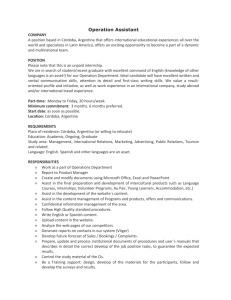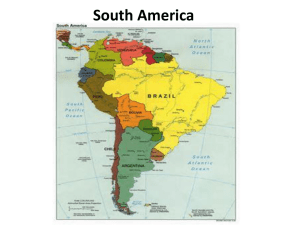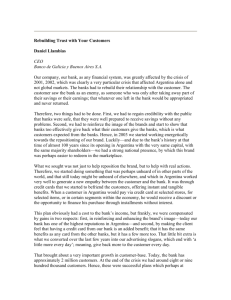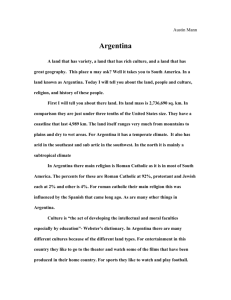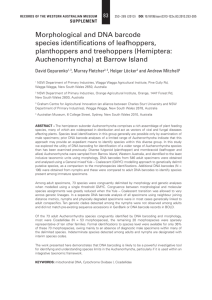Leafhoppers species richness and abundance on corn crops in
advertisement
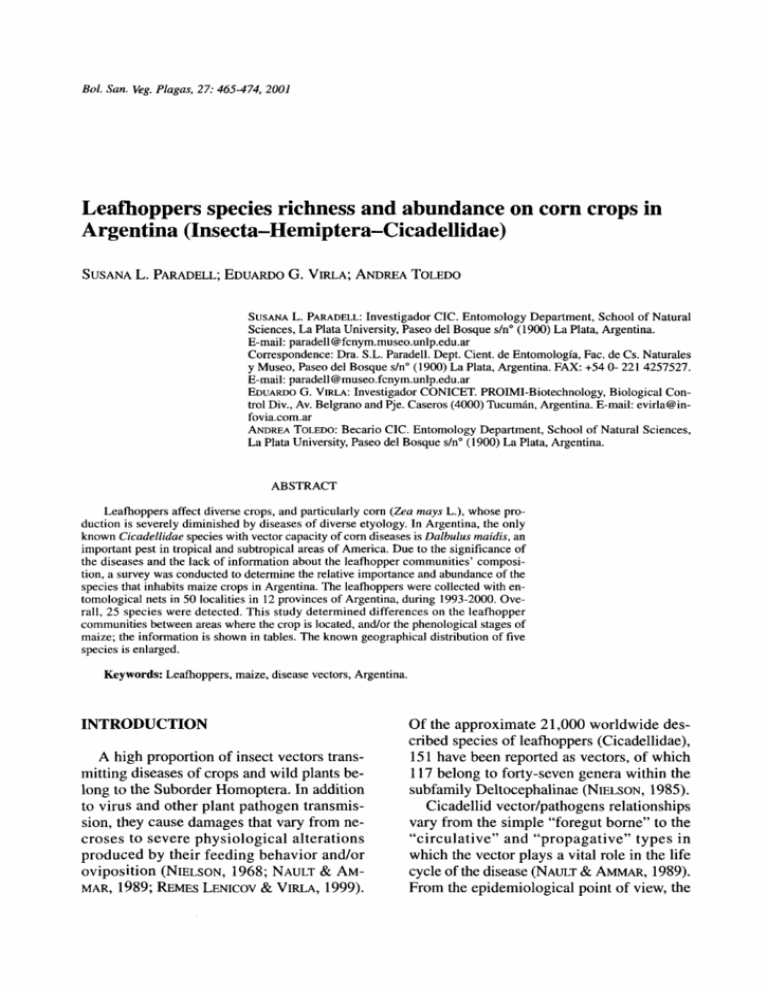
Bol. San. Veg. Plagas, 27: 465-474, 2001
Leafhoppers species richness and abundance on corn crops in
Argentina (Insecta-Hemiptera-Cicadellidae)
SUSANA L. PARADELL; EDUARDO G. VIRLA; ANDREA TOLEDO
SUSANA L. PARADELL: Investigador CIC. Entomology Department, School of Natural
Sciences, La Plata University, Paseo del Bosque s/n° (1900) La Plata, Argentina.
E-mail: paradell@fcnym.museo.unlp.edu.ar
Correspondence: Dra. S.L. Paradell. Dept. Cient. de Entomología, Fac. de Cs. Naturales
y Museo, Paseo del Bosque s/n° (1900) La Plata, Argentina. FAX: +54 0- 221 4257527.
E-mail: paradell@museo.fcnym.unlp.edu.ar
EDUARDO G. VIRLA: Investigador CONICET. PROIMI-Biotechnology, Biological Control Div., Av. Belgrano and Pje. Caseros (4000) Tucumán, Argentina. E-mail: evirla@infovia.com.ar
ANDREA TOLEDO: Becario CIC. Entomology Department, School of Natural Sciences,
La Plata University, Paseo del Bosque s/nc (1900) La Plata, Argentina.
ABSTRACT
Leafhoppers affect diverse crops, and particularly corn (Zea mays L.), whose production is severely diminished by diseases of diverse etyology. In Argentina, the only
known Cicadellidae species with vector capacity of com diseases is Dalbulus maidis, an
important pest in tropical and subtropical areas of America. Due to the significance of
the diseases and the lack of information about the leafhopper communities' composition, a survey was conducted to determine the relative importance and abundance of the
species that inhabits maize crops in Argentina. The leafhoppers were collected with entomological nets in 50 localities in 12 provinces of Argentina, during 1993-2000. Overall, 25 species were detected. This study determined differences on the leafhopper
communities between areas where the crop is located, and/or the phenological stages of
maize; the information is shown in tables. The known geographical distribution of five
species is enlarged.
Keywords: Leafhoppers, maize, disease vectors, Argentina
INTRODUCTION
A high proportion of insect vectors transmitting diseases of crops and wild plants belong to the Suborder Homoptera. In addition
to virus and other plant pathogen transmission, they cause damages that vary from necroses to severe physiological alterations
produced by their feeding behavior and/or
oviposition (NIELSON, 1968; NAULT & AMMAR, 1989; REMES LENICOV & VIRLA, 1999).
Of the approximate 21,000 worldwide described species of leafhoppers (Cicadellidae),
151 have been reported as vectors, of which
117 belong to forty-seven genera within the
subfamily Deltocephalinae (NIELSON, 1985).
Cicadellid vector/pathogens relationships
vary from the simple "foregut borne" to the
"circulative" and "propagative" types in
which the vector plays a vital role in the life
cycle of the disease (NAULT & AMMAR, 1989).
From the epidemiological point of view, the
study of this group is relevant because it affects several crops, particularly corn (Zea
mays L.), where production is severely diminished by diseases of diverse etyology.
In the Neotropical region the Cicadellidae
is one of the best-represented families and
although the leafhopper fauna of Argentina is
among the most thoroughly studied in South
America, the knowledge (based mostly on taxonomic and distributional data) are still insufficient. (REMES LENICOV et al, 1997). Only
few contributions focused the cicadellidshost relationships (REMES LENICOV & TESÓN,
1985; PARADELL, 1995 a, b; REMES LENICOV
et al, 1999; PARADELL et al, 2000).
Maize is one of the economically most
important cereals in Argentina. In 1996-97
3,800,000 ha were sown which yielded an
estimated of 1,460,000 t with an average
yield of 4.500 kg/ha.
There are three main maize pathogens in
Latin America: MRFV (Maize Rayado Fino
Virus), CSS "Corn Stunt" or "achaparramiento" (Corn Stunt Spiroplasm) and MBSP
(Maize Bushy Stunt Micoplasm), they are
transmitted in a persistant way by the leafhopper Dalbulus maidis (DE LONG & WOLCOTT).
Most of the cicadellid vector species are included in the Deltocephalinae subfamily and belong to the genera Dalbulus, Baldulus, Exitianus, Stirellus and Graminella (NAULT and
BRADFUTE, 1979; NAULT and MADDEN, 1985).
A comparison of the phylogenetic relationships of twenty-five Deltocephalinae species with their individual ability to transmit
Maize Chlorotic Dwarf Virus enabled NAULT
and MADDEN (1988) to predict that species of
Deltocephalini and "recent" Euscelini have a
higher probability of being vectors than species of the more "primitive" Euscelini and
Macrostelini. KNIGHT and WEBB (1993)
analyzed and established the phylogenetic relationships among diverse genera within the
Macrostelini (Deltocephalinae), and tested alternative hypotheses about the origin of the
ability to transmit plant phatogens.
The only cicadellid species with known
vector capacity of corn diseases in Argentina
is D. maidis (Lenardón et al., 1993) but surely
there are several other species involved in the
epidemiology of the corn spiroplams or phytoplasm-borne diseases. The discovery of
plants with symptomatology of the above
mentioned diseases in areas where D. maidis
is not registered should be highlighted. This
fact creates the necessity for studying other
species of Cicadellidae as possible vectors.
Due to the significance of the diseases and
the lack of information about the leafhopper
communities' composition, a survey was
conducted to determine the relative importance and abundance of the species that inhabits maize crops in Argentina. Analysis was
made in order to compare the presence and
importance of the different species and the
phenological stage of the crop in two agroecological maize sub-regions of Argentina.
MATERIALS AND METHODS
Between 1993 and 2000 a survey of the
Cicadellidae communities was carried out
on corn crop located in 12 provinces of Argentina. Insects were collected with an entomological net, during the crop season (between november and april). The obtained
data result from the analysis of non systematic samples (1 sample = 50 strikes), carried
out in 50 localities (see table 1).
The insects were put in glass jars, killed
with ethyl acetate and preserved in alcohol
70%. The phenological stage of the crop was
also noted. This allowed the samples to be divided into three categories: from V2 (vegetative with almost two leaves developed) to V7
stages; from V8 stage to the appearance of
the male inflorescence; and finally the reproductive stage (from the male inflorescence
maturation to the harvest of cultivation).
In Argentina, maize cultivation extends
from the 40° parallel South latitude to the
North. For the analysis, the argentine maize
area was divided in two sub-regions, the division axis was the 30° parallel (LS). The
separation of localities determined outlines
of two agroecological sub-regions, which
induce mainly the use of different types of
Pálpala (JU)
Yavi Chico (JU)
San Pedro (JU)
Humahuaca (JU)
Tilcara(JU)
Yuto(JU)
Tolombón (SA)
Talapampa (SA)
S.R. de la N. Oran (SA)
Pichanal (SA)
Metán (SA)
Ceibalito (SA)
Rosario de la Frontera (SA)
Apolinario Saravia (SA)
El Galpón (SA)
Piquete Cabado (SA)
Quebrachal (SA)
Villa Carmela (TU)
Rumi Punco (TU)
El Cadillal (TU)
Tafí del Valle (TU)
Ampimpa (TU)
Leales (TU)
Avellaneda (SF)
Helvecia (SF)
Sandford (SF)
El Palenque (ER)
Federal (ER)
Bovril(ER)
Vicuña Mackenna (CB)
Eduardo Castex (LP)
Olavarría (BA)
9 de julio (BA)
25 de Mayo (BA)
General Villegas (BA)
Fortín Olavarría (BA)
Bahía Blanca (BA)
Rojas (BA)
Colón - Morgan (BA)
Santa Catalina (BA)
Catriel(RN)
Ing. Huergo (RN)
Fernández (SE)
Suncho Corral (SE)
Sáenz Peña (CH)
Quitilipi (CH)
Las Breñas (CH)
Makalle (CH)
El Sombrero (CO)
San Roque (CO)
germoplasm. The sampled localities are listed in Table 1.
For each of the species the relative abundance (RA) and relative importance (RI) was
calculated using the following formula:
RI = (ni/nt) * (mi/mt) * 100
— ni: number of individuals in the species "i"
— nt: number of individuals in all species
— mi: number of samples where the species
appears "i"
— mt: total number of samples.
Those species having a RI > 1 are considered "frequent"; those having a RI from
0,02 to 0,99 are considered "not very frequent"; and those having a RI < 0,019 are
considered "rare or occasional".
It is important to note that some samples
did not have a clear mention of the phenological stage from which were taken; therefore, in the tables, the sums of the numbers
of individuals or samples that appear in the
different stages are different from those in
the total.
The examined insects were kept in the
Scientific Department of Entomology collections, School and Museum of Natural
Science, La Plata (Argentina).
RESULTS
We observed that there are some species
that occur exclusively to the North of the
30° parallel SL: Xestocephalus irroratus
Osborn, 1924 (Xestocephalinae); Tapajosa
rubromarginata (SIGNORET, 1855), Hortensia similis (WALKER, 1851), Erythrogonia
sp. (Cicadellinae); Empoasca sp. (Fabae
group) (Typhlocibinae); Bergallia confusa
Oman, 1938 (Agallinae); Chlorotettix neotropicus Jensen-Haarup, 1922; Chlorotettix
minimus BAKER, 1898; Balclutha rosea
(SCOTT, 1876) and Atanus coronatus (BERG,
1879) (Deltocephalinae); others occur to
the South of the same parallel: Syncharina
argentina (BERG, 1879), Plesiommata mollicella (FOWLER, 1900) (Cicadellinae);
Graminella puncticeps Linnavuori, 1959;
Exitianus obscurinervis (STÀL, 1859); Am-
plicephalus simpliciusculus Linnavuori,
1955; Amplicephalus marginellanus Linnavuori, 1955 (Deltocephalinae); and others in both regions: Xerophloea viridis
(FABRICIUS, 1794) (Xerophloeinae); Syncharina punctatissima (SIGNORET, 1854)
(Cicadellinae); Haldorus
sexpunctatus
(BERG, 1879); Chlorotettix
fraterculus
(BERG, 1879); Amplicephalus dubius (LINNAVUORI, 1955) and Dalbulus maidis (')
(Deltocephalinae); Empoasca manubriata
Young, 1953 and Empoasca
curveóla
Oman, 1936 (Typhlocibinae); Agalliana
ensigera Oman, 1934 (Agallinae). The occurrence of these species in the different
localities is summarized in Table 2.
There were no collected cicadellid specimens in the following localities: Quebrachal
(Salta province); SUNCHO CORRAL and FERNÁNDEZ (Santiago del Estero province); Las
Breñas, SÁENZ PEÑA, MAKALLE and QUITI-
LIPI (Chaco province); San Roque and El
Sombrero (Corrientes province); and BOVRIL
(Entre Rios province).
After the analysis of the data obtained
from both agroecological regions, the five
species with the highest relative importance
are Dalbulus maidis (13.56), Exitianus obscurinervis (4.24), Haldorus sexpunctatus
(3.07), Empoasca curveóla (2.16), and Agalliana ensigera (1.88).
Syncharina punctantissima, S. argentina,
Amplicephalus dubius, Balclutha rosea,
Chlorotettix fraterculus, Xerophloea viridis,
Empoasca manubriata and Tapajosa rubromarginata are not very frequent species.
However Plesiommata mollicella, Amplicephalus marginellanus, A. simpliciusculus,
Empoasca sp. (fabae group), Atanus coronatus, Graminella puncticeps, Chlorotettix minimus, C. neotropicus, Xestocephalus irroratus, Hortensia similis, Bergallia confusa
and Erytrogonia sp. are rare or occasional
species.
1
It appears in only one locality, in the region located to
the South of the 30° parallel (Helvecia, Santa Fe province - 30° 57' S and 58° 47' W).
Haldorus sexpunctatus (RI: 10.9), Dalbulus maidis (RI: 9.59) and Exitianus obscurinervis (RI: 8.22) are the most important species in the earliest vegetative stages (V2 to
V7). D. maidis (RI: 25.45) is most important
during the final vegetative stage and Exitianus obscurinervis (RI: 5.38) and A. ensigera
(RI: 3.47) behaves in a similar way. After the
formation of the male inflorescence and up
to the end of cultivation the more significant
species is D. maidis (RI: 25.26), and the species that appear as occasionally important
during this period are Empoasca manubriata
(RI: 0.53) and A. ensigera (RI: 0.53).
The analysis of the data obtained from
samples made in the northern agroecological
subregion demonstrates that the most abundant and frequent species is D. maidis together with A. ensigera.
X. viridis, C. frateuculus, T. rubromarginata, H. sexpunctatus, E. curveóla, Empoasca sp. (fabae group), E. manubriata, B. rosea and A. coronatus are not very frequent
species. The rare or occasional species are
C. minimus, C. neotropicus, X. irroratus, A.
dubius, S. punctatissima, H. similis, B. confusa and Erytrogonia sp (Table 3).
The analysis of the data obtained from
samples made in the southern agroecological
subregion shows that the most frequent species is E. obscurinervis and then in order of
importance H. sexpunctatus, E. curveóla, A.
ensigera and S. punctatissima.
S. argentina, P. mollicella, A. marginellanus, E. manubriata, X. viridis, G. puncticeps
and A. simpliciusculus are not very frequent
species; meanwhile D. maidis and C. fraterculus are very rare or occasional species (Table 4).
each species were given without information
about the relative importance or abundance
of their populations. Throughout this study
the relative abundance and importance of 25
species that relate to maize crop in Argentina are established. In the available literature we were not able to find similar studies
written in another South American country
with which to compare it.
Nine of the 25 species are widely spread
and are present in all of the monitored corn
agroecosystems. Ten species were found
only in localities to the North of the 30° parallel LS while six species were present only
to the South of this parallel.
The geographical distribution of five species is enlarged: Chlorotettix fraterculus and
Bergallia confusa are new to Jujuy province;
Balclutha rosea and Erythrogonia sp. are
new to Salta province, Dalbulus maidis are
new to Jujuy and Santa Fe provinces. Erythrogonia sp. and Chlorotettix minimus were
quoted for the first time on maize crops in
the region.
Because the occurrence of CSS disease
and plants with symptomatology of the
phytoplasm-borne diseases are in areas
where D. maidis (the only known vector
present in Argentina) is absent, we suggest
that Exitianus obscurinervis, Haldorus sexpunctatus, Amplicephalus dubius, Agalliana ensigera, Syncharina punctatissima
and Empoasca curveóla are the prime candidates for use in transmission tests. E. obscurinervis is present in 90% of the monitored localities to the south of the 30° parallel
LS and due to it frequency and abundance it
could be involved in the epidemiology of
these diseases.
CONCLUSIONS AND DISCUSSION
AKNOWLEDGEMENTS
PARADELL (1995 a) based on literature
and the examination of specimens deposited
in diverse entomological collections reported 31 species associated with maize crops
in Argentina. In that contribution, only a
brief description and distributional data of
LENICOV and the anonymous reviewer compelled us to rewrite part of this contribution,
hopefully with some improvement! many
thanks to them and to REGINA FRASER and
The comments of DRA. A.M. DE REMES
ALSHIA LUGO for checking the English.
RESUMEN
Los homópteros auquenorrincos (chicharritas) afectan diversos cultivos, en especial
maíz {Zea mays L.), cuyas producciones se ven severamente disminuidas por enfermedades de diversa etiología. En Argentina, la única especie de Cicadellidae reconocida
como vector de enfermedades al maíz es Dalbulus maidis, importante plaga en áreas
tropicales y subtropicales de América. Debido a la importancia de las enfermedades y la
marcada carencia de información referida a la composición faunística de las comunidades de cicadélidos, se llevaron a cabo relevamientos tendientes a determinar la abundancia e importancia relativa de las diversas especies que habitan en cultivos de maíz de Argentina. Los Cicadélidos fueron recolectados con red entomológica de arrastre en 50
localidades distribuidas en 12 provincias de Argentina entre los años 1993-2000. En total, se listaron 25 especies. Este estudio determina las diferencias en las comunidades de
Cicadélidos según el área de localización del cultivo y/o el estado fenológico en el cual
se encuentra; esta información es mostrada a través de tablas. Se amplía la distribución
geográfica de cinco especies.
Palabras Clave: Cicadellidae, maíz, vectores de enfermedades, República Argentina.
REFERENCIAS
KNIGHT, W.J., WEBB, M.D.1993. The phylogenetic relationships between virus vector and other genera of
macrosteline leafhoppers, including descriptions of
new taxa (Homoptera: Cicadellidae: Deltocephalinae). System. Entomol., 18: 11-55.
LENARDON, S., LAGUNA, I., TRUOL, G., GORDON, L.,
BRADFUTE, O., GÓMEZ, G. 1993. Identification of
corn stunt spiroplasma in maize from Argentina.
Plant Disease, 77: 100.
NAULT, L. & BRADFUTE, O. 1979. Corn Stunt: involvement of the complex of leafhopper-borne pathogens.
In: "Leafhoppers vectors and plant disease agents",
MARAMOROSH, K. & K. HARRIS (Editors) Academic
Press, New York: 561-586.
NAULT, L. & MADDEN, L.V. 1985. Ecological strategies
of Dalbulus leafhoppers. Ecol. Ent. 10: 57-63
NAULT, L. & MADDEN, L.V. 1988. Phylogenetic related-
ness of Maize Chlorotic Dwarf Virus leafhopper vectors. Am. Phytopathology Soc. 78: 1683-1687.
NAULT, L. & AMMAR, E.D. 1989. Leafhoppers and
planthoppers transmission of plant viruses. Annu.
Rev. Entomol. 34: 503-529.
NIELSON, M.W. 1968. The leafhoppers vectors of Phytopatogenic viruses (Homoptera, Cicadellidae). Taxonomy, biology and virus transmission. Technical
Bulletin 1382, U.S. Dept. of Agriculture. Washington, 386 pp.
NIELSON, M.W. 1985. Leafhopper systematic. In: "The
leafhoppers and Planthoppers", NAULT, L. R. & J.G.
RODRIGUEZ, (Editors), Wiley & Sons, New York : 1139.
PARADELL, S. 1995a. Especies argentinas de Homópteros
Cicadélidos asociados al cultivo de maíz (Zea mays
L.). Rev. Fac. Agronomía (La Plata) 71: 213-234.
PARADELL, S. 1995b. Estudio sistemático de los tiflocibinos argentinos del género Empoasca (Homoptera,
Cicadellidae). Rev. Soc. Entomol. Arg. 54: 113-153.
PARADELL, S., REMES LENICOV, A.M. DE, DE COLL, O.,
AGOSTINI, J. 2000. Cicadélidos asociados a citrus
afectados por la Clorosis Variegada de los Citrus
(CVC) en Montecarlo, Misiones, República Argentina (Hemiptera: Auchenorryncha). Rev. Soc. Entomol. Arg. 59: 103-118.
REMES LENICOV, A.M. DE, PARADELL, S., VIRLA, E.,
VARELA, G., COSTAMGNA, A., MARIANI, R. 1997. Ci-
cadélidos y Delfácidos perjudiciales a cultivos de
maíz en la República Argentina (Insecta-Homoptera). Anales VI Congreso Nacional de maíz. Pergamino, Buenos Aires, Arg. Tomo I. Mesa II: 58-74.
REMES LENICOV, A.M. DE y TESÓN, A. 1985. Cicadéli-
dos que habitan los cultivos de arroz. (Homoptera,
Cicadellidae). Rev. de Investigaciones Agropecuarias
(INTA, Buenos Aires, Arg.) 20: 131-141.
REMES LENICOV, A.M. DE Y VIRLA, E. 1999. Homópte-
ros vectores de interés fitosanitario: un problema creciente en Argentina. Rev. Soc. Entomol Arg. 58: 4347
REMES LENICOV, A.M. DE, PARADELL, S., DE COLL, O.,
AGOSTINI, J. 1999. Cicadelinos asociados a Citrus
afectados por Clorosis variegada (CVC) en la República Argentina (Insecta: Homoptera: Cicadellidae).
Rev. Soc. Entomol Arg. 58: 211- 225.
(Recepción: 17/09/01)
(Aceptado: 21/11/01)




